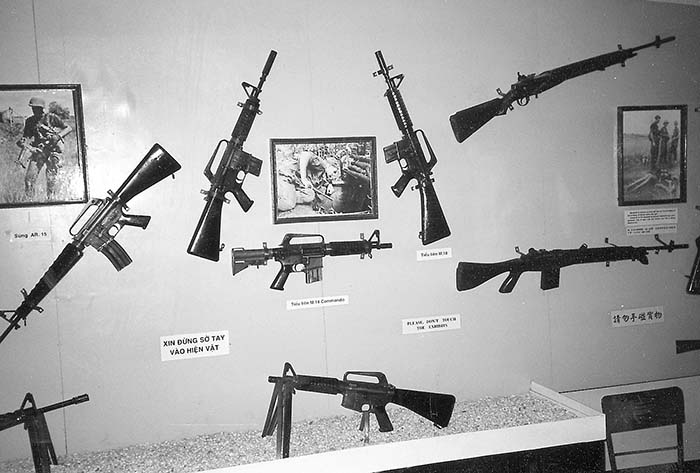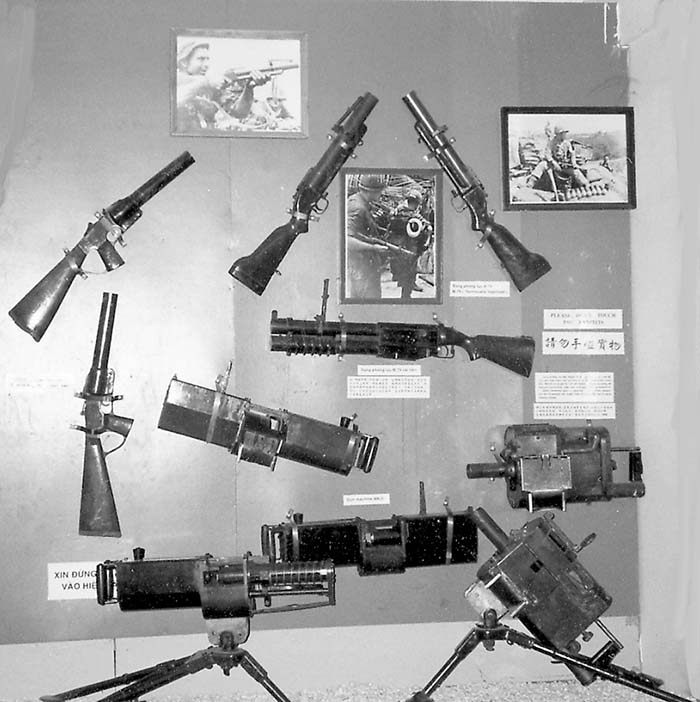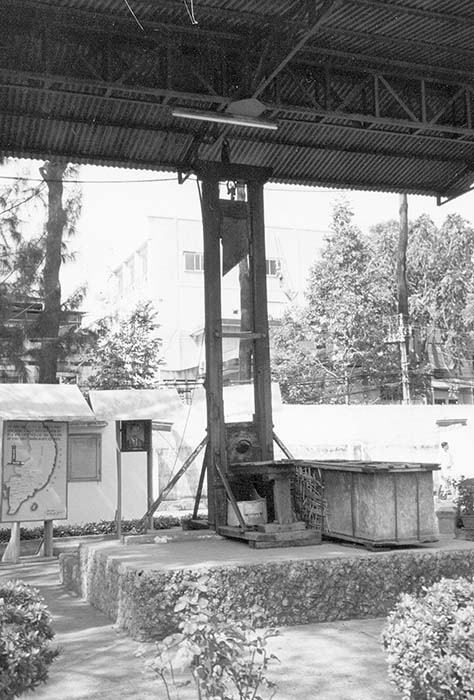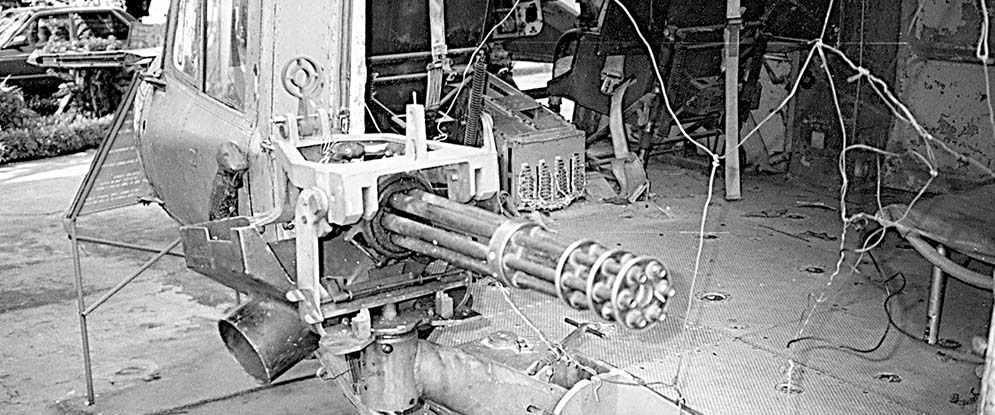By Michael Shyne
Lead Photo: The remains of a chopper mounted Mini-Gun.
Imagine entering a military museum and being greeted by a statement like this: “Yet we were wrong, terribly wrong. We owe it to the future generations to explain why.” Robert S. McNamara.
Thus began the welcome to Vietnam’s War Remnants Museum. “Remnants” of war much different from the “remnants”, what remains, what is left over, which we are used to contemplating. Yet, that is the purpose for which this museum in Communist Vietnam was established, to contain what remains, to keep anti-American memories alive, to justify the actions of North Vietnam during the war and to support the Communist government of Vietnam.
SAR visited Hanoi, Ho Chi Minh City (Saigon), Cu Chi and the Mekong. The evidence is clear; Vietnam is looking to the future. Since its Communist government’s amazing move in 1985 to convert this country’s economy to a free market economy, Vietnam is accelerating into the 21st century. A middle class is developing from its citizens’ unprecedented post-war economic opportunities. Yet, although the government’s focus is on building future international relations and a strong internal economy, memories of the war are preserved, manipulated and promoted.
Thoi Som Island on the Mekong River, once a heavily bombed Vietcong stronghold, is now a resort known for its tropical fruit. The unconquerable tunnels of Cu Chi are now accessible to the public, complete with booby trap displays, a souvenir shop and a Vietnam-era weapons live fire shooting range. But the most graphic display of a one-sided preservation of the Vietnam War encountered by this writer was the War Remnants Museum.
The museum grounds included equipment displays featuring examples of some of America’s more exotic bombs, a 15,000 pound “seismic bomb” claimed to be effective over a 3 kilometer area and a CBU-55B designed to “destroy all the oxygen within a radius of 500 meters”. U.S. light and heavy artillery were on display as well as attack-equipped T-33 and F-5 jet aircraft. Nearby, a UH1 Huey sported a somewhat cannibalized Minigun.
The Communist counterbalance to all of this sophisticated weaponry is a twelve foot tall portable guillotine. This is the very guillotine the Communists carted from province to province, from hamlet to hamlet, executing citizens who had shown a partiality towards the South Vietnamese or the Americans. The contradiction in technology was profound.

The Communist government’s intent of this museum is to demonstrate the brutality and senselessness of U.S. actions. Statistics were given comparing the number of tons of bombs dropped over Vietnam by the U.S., versus our similar contribution to World War II. The statistics included the number of schools, hospitals and religious buildings destroyed in North Vietnam and the comparison of the nearly 3 million Vietnamese casualties to the 58,000 American casualties.

The War Remnants Museum bore a close similarity to the many holocaust museums existing in America today. The Jewish statement “Never Again” is not unlike the Vietnamese equivalent: “In retrospect, it is not for inciting hatred, just for learning lessons from history: human beings will not tolerate such a disaster happening again, neither in Vietnam nor anywhere on our planet”.
Interior displays included poster-sized photographs of American soldiers involved in the destruction of Vietnam and its citizenry. Many of the photographs are horrendously graphic. That is the purpose of this museum: to show “America’s war abuse”. Expectedly, the other side of the coin is conspicuously absent: the equally disgusting Communist atrocities. What this museum is unintentionally displaying is Communist Vietnam’s inability to be self-critical. America’s Democracy creates a safe environment to present and debate mistakes we may have committed. But Communism has no such mirror to reflect its shames along with its pride. Vietnam’s War Remnants Museum is an unmistakable demonstration of its national shortcoming.
Today, sixty percent of Vietnam’s population is younger than twenty-five years of age! Sixty percent of the country’s population does not have personal experience in the war. Possibly for this demographic reason, the War Remnants Museum is oriented towards retaining the memory of the war and American violence against the Vietnamese. Exhibits are in both Vietnamese and English. Yet, coincidentally, during this writer’s visit to the Museum, the majority of the visitors were non-Vietnamese, primarily American and a few Europeans. Some of the Americans had a hard time digesting the graphic illustrations of the war. One photo depicted a body being thrown from a Huey a thousand feet above the ground with the caption “Refusing to answer interrogations, a man is being thrown from a flying helicopter”. A visitor’s comment this author overheard was “That’s a bald-faced distortion”. Yet the photograph was claimed to have been taken from a specific issue of Life Magazine, a fact easily documented. I saw no need to document it, having heard duplicate stories directly from Americans on the scene when such events took place. Ironically, most of the photographs appeared to have been taken by U.S. GIs or newsmen.
It is difficult for the majority of us, living a life secure and distant from the reality of human conflict, to understand the distortions of “sanity” such conflicts create. Criticism is easy, but by “walking in their shoes,” would we have acted differently?
The photo gallery was strictly a one-sided representation of the atrocities of war, showing nothing of the butchery which took place at the hands of the North Vietnamese and Vietcong. Thus, it is doubtful the sixty percent of the country’s population with no war experience, will ever see similar examples of the atrocities committed by their countrymen. They may never learn that their government’s intent is to indoctrinate them in the one-sided picture of atrocities inflicted upon their nation by the invading Americans. This may be an example of their government’s struggling attempt to counterbalance the peaceful evolution taking place in Vietnam today. Vietnam’s Communist government has much to fear, for this is an evolution from Communism to free enterprise, economic independence and eventually Democracy.

The peaceful evolution of Vietnam will take place, in part from the growing interest in establishing English as a second language. Surprisingly, one of the most popular prime time television shows is not Baywatch, the world-wide hit elsewhere on this planet, it is an English lesson!
The small arms exhibits were somewhat less propagandized, giving a good representation of the weaponry used on both sides of the war. On display were many fine small arms, including a variety of Colt M-16s, M-14s in several configurations and an interesting selection of .45 Thompsons and 9mm subguns used by our soldiers.
Grenade launchers were well represented, along with gas guns, all considered equal in this museum display. Several of the belt-fed grenade launchers appeared to be early prototypes of contemporary weaponry. But this author’s favorite was the display of miniguns and the unique feed system attached to one of the examples.
Next to the recoilless rifle in the center of the display was a single shot weapon bearing no similarity to anything with which this author is familiar. Photos are enclosed, hoping readers can identify this weapon.
Don’t worry, these small arms will be around for years, well protected from the intense monsoon humidity in Vietnam. The number of coats of varnish applied to these firearms will preserve them for posterity; hopefully, for Class 3 collectors once America’s laws are amended to again allow such imports for dedicated collectors of war history.
Propaganda was not absent in the small arms displays, though it was almost comical to a Reasonably Knowledgeable Individual (RKI). Colt and Smith and Wesson 357 Magnum revolvers were classified as “excessive”. 1918 A-2 Browning automatic rifles were referred to with disgust of their potential for overkill. Yet, displayed alongside them was the world’s foremost assault rifle, the Kalashnikov AK-47 and its Chinese counterparts, as well as the lethal belt-fed and highly mobile RPD. Conspicuously absent were examples of the feared booby traps which impaled too many American soldiers.
Possibly the envy of the display were the 4 miniguns. Yes, 4 complete miniguns, causing this author to ponder opportunities for post-86 imports!
The War Remnants Museum in Ho Chi Minh City is communist Vietnam’s one-sided representation of the atrocities of the war. Yet, who could expect otherwise. A visit to this museum is a valuable experience. Not only are the small arms and heavy equipment displays of interest and sometimes unique, but the visit reminds us of the pain and misery, of the profound sacrifice the war in Vietnam exacted from everyone involved, directly and indirectly.
The easy road is the road of blame, undoubtedly present in the minds of some of the readers of this article. It is much easier to cast blame and remain entrenched in the past, not unlike those members of our nation who are still refighting the Civil War. The much more difficult approach is that taken by many Americans and many Vietnamese. Theirs is the choice to look forward, a courageous choice in view of the suffering inflicted on all participants of battle. As one Vietnamese government official told me, “We have chosen to look forward to a new relationship between Vietnam and America”.
May we all choose to change our angle of view from looking back at the past, as former enemies, to a view of the future with a new cooperation and partnership between the United States of America and the Socialist Republic of Vietnam.
This article appeared in part in SAR Volume 1 Number 1, but it is so poignant to the subject, that we decided to present it again, updated and revised, in our Small Arms of Vietnam issue- Dan
| This article first appeared in Small Arms Review V5N7 (April 2002) |











